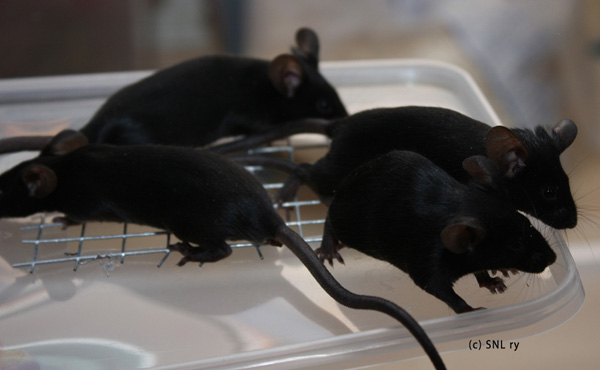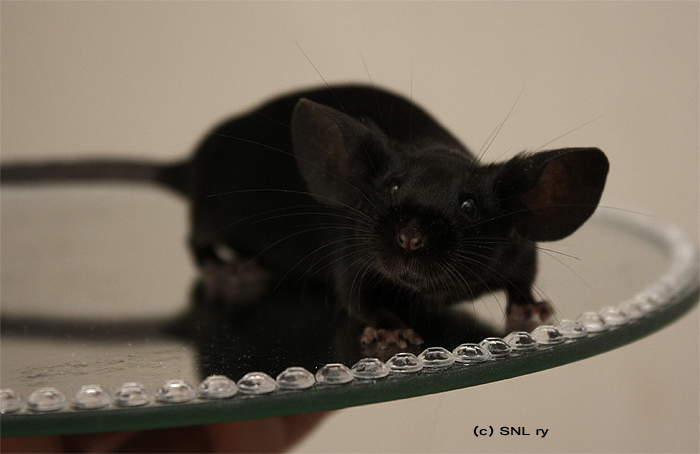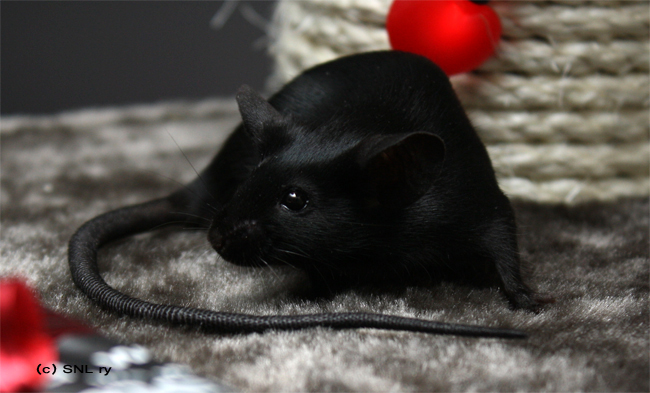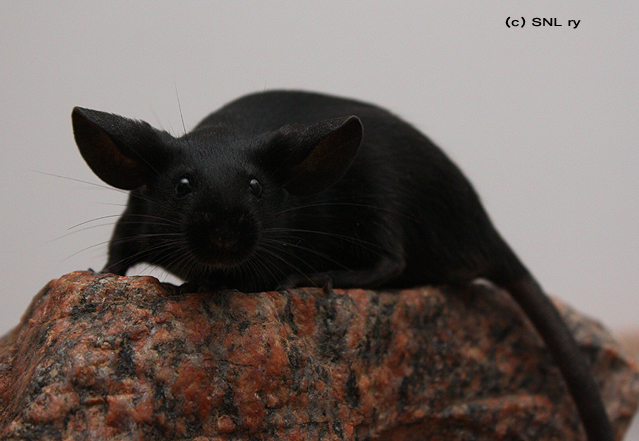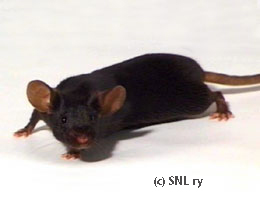Varieties
I - Self
Black (ba)
a/a B/* D/* C/* P/*
or ae/ae B/* D/* C/* P/*
"The colour should be dense, lustrous black. Eyes black."
Breeding information below the pictures.
Quick Look
Black should be a jet black mouse, including the feet, tail and ears. Common faults with blacks include tan or white hairs in the coat, light or white feet, brown or greyish tinge to te colour and lighter belly. The faulty tan (or white) hairs can be usually found in the following locations: on the throat (throat spot); behind the ears and inside the ears; along the sides where the demarcation line would be, if the mouse was a black tan; around the teats on females; around the vent; on the feet. Of these, the throat spot and tan around the vent seem to be the most persistent faults to breed out.
Genetic Background
The genotype of a black is very simple. The only mutation when compared to the wild type is small a: a/a. All the other genes on the mouse are those of the full colour.
The official name of the gene (in genetic parlance allele) that makes a mouse black instead of agouti is nonagouti and it is a spontaneous recessive mutation of nonagouti. The official geneticist's symbol is a. It is located in chromosome 2.
The colour of the mouse changes from the ticked wild type (agouti) to self (black), because of the agouti locus controls the amount and distribution of phaeomelanin (yellow pigment) and eumelanin (black pigment) in the mouse's hairs. The effect of a/a is to make the whole of the hair develop uniform black colouring instead of having "banded" agouti colouration. Hairs that are all yellow (that is the tan ticking and throat spots) are also of one colour instead of being banded, but they are yellow (tan) instead of black.
The deep black mouse you get with the extreme non-agouti gene ae is different from basic black mouse in the a-locus: instead of a/a, it has ae/ae.
In More Practical Terms...
In addition to the faults listed above, blacks can have also other faults that should be bred out or in many cases, kept out of the lines. Tail tips and white or light toes are among these faults. These can be brought in from breeding blacks with varieties where these faults can lie hidden, like pink eyed whites or marked varieties. Light toes seem to respond well to selective breeding. black mice with tail spots and/or clearly white toes would be better left out of the breeding program completely - including using these mice to breed marked varieties. It should go without saying, that you shouldn't use mice with other white spotting faults either. If a line of blacks constantly throws white areas, it may even be better to stop breeding that line altogether.
On common a/a blacks, there will always be some tan hairs around, so the breeder will have to try to breed for as few of them as possible. This can take a lot of patience, but with continued selective breeding it can be done. Along with eliminating tan hairs, the breeder should be on a constant look-out for getting the black colour as deep a black as possible for the whole length of the hairs and all over the mouse's body.
With the extreme non-agouti gene ae it is possible to get a black that really does meet the standard's requirements. This gene removes all the redness in the coat, but this doesn't mean that the hairs that would be tan on a a/a black would simply be removed - those hairs are still there and need to be bred out, their colour has just been reduced from tan to white. However, the colour of a ae/ae black is a deep black indeed, giving a very pleasing overall appearance.
Black is best mated with another black, ae/ae black with another of the same genotype. Everything else tends to weaken the colour somewhat. More specifically on ae/ae blacks later on.
Outcrosses would better be avoided altogether, but that isn't of course always possible. Sometimes this is due to lack of usable black mice, sometimes an outcross is needed to give good blacks size and type.
When looking for possible outcrosses for a self variety, let's look at other self varieties first. The best outcross is good blue, although using blues might bring in lighter toes. Varieties with the chocolate dilution cordovan (bc) or brown dilution (b) aren't recommended, because they bring in a brownish tinge to the black. This isn't a case of B/b or B/ bc causing the brownish tinge as such, or the two genes interacting, but due to chocolates and especially champagnes having a quite different set of modifying genes built for the benefit of their respective colours. Lilac isn't suitable for the same reason as chocolate or champagne - it is a b/b (or bc/*) variety.
The pink-eyed version of the same basic genotype than black, dove, might sound like a good outcross - after all, the only difference is the colour of the eyes, isn't it not? Well, things aren't quite that simple in the art of mouse breeding, as the dreaded modifiers come into play yet again. The problem with using dove for an outcross of black is that what's required of the colour of a good dove is very different than what's required from the colour of a good black - one is selectively bred for rather a light colour, the other to be as dark as possible. Silvers have the same problem and aren't thus recommended either.
Fawn and red aren't good for black as they usually have b/b (or bc/*) or even Ay/A b/b (or bc/*), which would give you brown dilution carrying blacks or agoutis in the first generation. blacks don't generally do any good for red either, as it would bring in sootiness (blacks are pretty likely to have Umbrous determinants). Black x fawn -combination would basically get you sooty reds... A bit different a case with these Ay varieties may be ae/ae black. Here again, the black would suffer in colour, but fawn and red might benefit. At least according to geneticist sources Ay/ae mouse would have a much darker red colouring than Ay/* mice. On the other hand, sources with more practical experience say that the result would be sable...
What about pink eyed white or bone? Or beige? While these varieties, especially PEW and bone, can bring in excellent size and type, they can also bring in surprises. Pink eyed whites can carry almost any colour or markings there is, so unless you are using PEWs with specifically black background (which can be very hard to come by, as this background wouldn't be that good for the size and type of a PEW), the resulting black mice can be of virtually any quality. Bones and beiges can have b/b lurking under the extreme dilution induced colouring and are also bred to be rather light colours. This wouldn't do that much good for the colour of black. Of course, if the background of the bone or beige to be used is known - that is, it's known to be a/a B/* D/* ce/c P/* for bone or a/a B/* D/* ce/ce P/* for beige - they might be useful at least for the size and type, but it might be better to use a too dark a Bone or beige than one that meets the standards.
Ticked and silvered varieties are pretty much to be completely counted out as suitable outcrosses for blacks, as are varieties of the tan and fox section. Ticked varieties aren't really selectively bred to not have tan ticking, so they'll bring that problem in, even the ticked variety that is the least unsuitable: agouti. Black tans bring a great deal of tan ticking along the sides and other tanned varieties bring that and the problems that their respective self 'versions' would bring.
When it comes to the shaded varieties, very good, dark siamese seal point or himalayan (or colorpoint beige or burmese) might be used without causing too much trouble for the black, although these pointed varieties do benefit more from the outcross than the self black. Diluted pointed varieties aren't recommended.
Sable would bring umbrous determinants to the black, which would help getting the mouse darker. On the other hand, this combination would also bring in lighter belly and tan ticking. Using marten sable would bring in chinchilla gene (cch) and eventually get you mock chocolates.
Of the marked varieties, a breeder can somewhat successfully run a line of self blacks and marked blacks, if the marked variety is a simple dominant. In essence, this leaves banded and rumpwhite... Variegated, while dominant, is anything but simple.
Granted, all what is said above on outcrosses holds truest with mice that are good representatives of their own variety. Sometimes a, say, dove mouse can be quite good an outcross for black - but this dove mouse would be considerably too dark to be considered a good dove.
At this point you may be thinking: "Hey, wait a minute! She has just listed pretty much all the standardized varieties except for black as not recommended for breeding black!" Yes I did, and that's intentional. While you can sometimes get very good blacks (or what ever variety) from quite unorthodox combinations, these are the odd occasions. Do try to keep your lines pure and when you do have to use an outcross, do it carefully so as not to ruin your whole line with a combination that turns out to be bad. When selecting an outcross, try to find a mouse of a variety with as similar a genotype as possible to the variety you are aiming for, as well as qualities that may be a fault in the outcross mouse's variety, but useful for the black, like too dark colouring on an agouti.
Those Truly Black Mice
Now, back to the ae/ae blacks. If you do have ae/ae blacks, be very careful with them. That is, use outcrosses very carefully and systematically, with careful follow-through breeding plan so you won't "lose" the recessive aes in the process. ae/ae black is very helpful in breeding for darker pointed Himalayan and siamese of both recognized point colours.
Starting From Scratch?
If you don't have blacks to start with and truly cannot find any, you can produce them by for example the following combinations: blue x chocolate, blue x champagne, chocolate x silver, chocolate x dove, blue x dove (or himalayan x chocolate / blue, if the himalayan in question actually is a "black pointed" instead of dilute-pointed one and not a siamese chocolate point with too light body colour; or siamese seal point x chocolate etc.) All of these bring blacks in the first generation, leaving the breeder to eliminate out faults in the colour.



